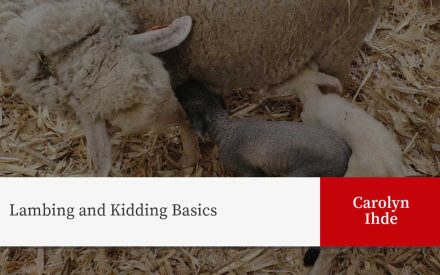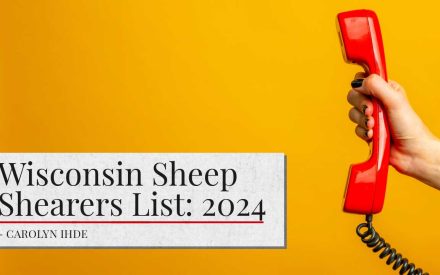How often have you looked at a lamb crop and thought, “Do I sell them or feed them out?” Perhaps, you wonder, “What is my breakeven for this year’s production?” Or “Is expanding the flock a good business decision?” As a sheep producer, I have asked myself the same questions. UW-Madison Extension’s Sheep Operation Enterprise Budget can help farmers answer these questions. This interactive Excel spreadsheet estimates the cost of production using your farm’s historical and current data. Utilizing records and an enterprise budget can assist in answering these questions and making informed decisions.
A useful budget, close-out, and profit measurement tool
A budget is a forward look into an enterprise’s economic outlook while a close-out looks back. The spreadsheet can calculate a close-out for a production cycle to determine the actual cost of production. Budgets and close-outs can be made for the ewe flock, finishing lambs in a dry lot or on grass. Download a copy of the Sheep Operation Enterprise Budget to determine the past year’s production costs and profitability, and develop budgets for evaluating next year’s profitability. Accurate closeouts and projections can help identify the sheep enterprises’ strengths and areas for improvement.
Analyzing the spreadsheet can show where changes can be made within the operation to increase profitability. Measuring and recording expenses, market values, and income over many years can help understand patterns and determine the enterprises’ “normal” cost of production. A budget created using the farms’ historical data and estimated input cost and market values will be more in tune with your operation and the impact of changes more predictable.
Separate ewe flock and lamb finishing operations in the spreadsheet tool
When evaluating the sheep operation, it is important to recognize the ewe flock and the lamb finishing operations as separate enterprises. The ewe flock should not be held accountable for the costs the lambs incur after being weaned and fed out. Upon weaning or shortly after, lambs are either sold as feeders or retained and fed out in a dry lot or pasture-based finishing system. At this point, the lambs should be considered their own enterprise on the farm. Think of it this way; the ewes are responsible for covering their yearly maintenance costs and the cost incurred for a lamb until weaning; her “income” is generated by selling her lamb(s). For record-keeping, her lambs are sold off at the market or to the on-farm lamb finishing operation at opportunity cost (the price they could be sold for at the time of transfer). The lamb is then responsible for generating revenue over the cost of feeding and care from weaning to finishing.
Every sheep operation has its own unique parameters in which it operates. The budget tool was created to recognize the diverse nature of sheep production in Wisconsin. The tool is customizable, with several options for tailoring the data to capture the unique aspects of the enterprise. In the ewe enterprise, income sources include the sale of feeder lambs, wool, breeding stock, and cull animals. Expenses include feed (including home-grown feed) and vitamins, minerals and supplements, bedding, replacement animals, veterinary supplies, and services. Inputs generated on-farm should be priced at fair market value. The budget tool helps users prorate overhead costs incurred by the sheep enterprises.
Breakeven and sensitivity analysis inform sound business decisions
The Breakeven and Sensitivity analysis sections show changes in profit or loss based on input costs. The sensitivity analysis shows changes in profit or loss based on potential changes in the sale price and feed costs. The breakeven calculator demonstrates how decisions can change the breakeven on paper when a producer makes changes to inputs or to possible income before making those changes on-farm. Feed costs are typically the highest cost of livestock enterprises and have the biggest potential to influence profitability, and being able to see those changes can help make sound business decisions.
In times when the profit margins are tight, it’s easy to say, “We need to make some changes.” However, without knowing how and where money is coming into and going out of the enterprise, cuts may be detrimental instead of beneficial. Using the Sheep Operation Enterprise Budget will let you analyze the sheep enterprise and assist in making decisions to reduce risk and hopefully, increase profitability.

 Lambing and Kidding Basics
Lambing and Kidding Basics Wisconsin Sheep Shearers List: 2024
Wisconsin Sheep Shearers List: 2024 Composting mortalities to improve biosecurity
Composting mortalities to improve biosecurity Preliminary forage recommendations for grazing solar sites
Preliminary forage recommendations for grazing solar sites


